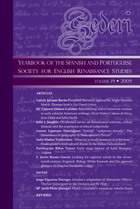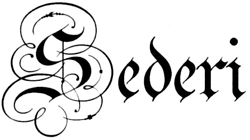
Sederi 19
Sederi 19 — 2009
EDITOR
Ana Sáez-Hidalgo
REVIEW EDITOR
Francisco José Borge López
ISSN 1135-7789
Mª Carmen Gomez Galisteo, “Representing Native American Women in Early Colonial American Writings: Álvar Núñez Cabeza de Vaca, Juan Ortiz and John Smith.” SEDERI 19 (2009): 25-45.
DOI: https://doi.org/10.34136/sederi.2009.2 Download PDF
Abstract
Most observers of Native Americans during the contact period between Europe and the Americas represented Native American women as monstrous beings posing potential threats to the Europeans’ physical integrity. However, the most well known portrait of Native American women is John Smith’s description of Pocahontas, the Native American princess who, the legend goes, saved Smith from being executed. Transformed into a children’s tale, further popularized by the Disney movie, as well as being the object of innumerable historical studies questioning or asserting the veracity of Smith’s claims, the fact remains that the Smith-Pocahontas story is at the very core of North American culture. Nevertheless, far from being original, John Smith’s story had a precedent in the story of Spaniard Juan Ortiz, a member of the ill-fated Narváez expedition to Florida in 1527. Ortiz, who got lost in America and spent the rest of his life there, was also rescued by a Native American princess from being sacrificed in the course of a Native American ritual, as recounted by the Gentleman of Elvas, member of the Hernando de Soto expedition. Yet another vision of Native American women is that offered by Álvar Núñez Cabeza de Vaca, another participant of the Narváez expedition who, during almost a decade in the Americas fulfilled a number of roles among the Native Americans, including some that were regarded as female roles. These female roles provided him with an opportunity to avert captivity as well as a better understanding of gender roles within Native American civilization. This essay explores the description of Native American women posed by John Smith, Juan Ortiz and Álvar Núñez Cabeza de Vaca so as to illustrate different images of Native American women during the early contact period as conveyed by these works.
Keywords: Native American women; Álvar Núñez Cabeza de Vaca; The Account; Naufragios; Juan Ortiz; Captain John Smith; Pocahontas.
References
Abrams, Ann Uhry. 1999 The Pilgrims and Pocahontas: Rival Myths of American Origins. Boulder and Oxford: Westview Press.
Adorno, Rolena. 1991 “The Negotiation of Fear in Cabeza de Vaca’s Naufragios.” Representations 33: 163-199.
Balfour, Mark 1995. “Moses and the Princess: Josephus’ Antiquitates Judaicae and the Chansons De Geste.” Medium Aevum 64: 1-16.
Baym, Nina. 1981. “Melodramas of Beset Manhood: How Theories of American Fiction Exclude Women Authors.” American Quarterly 33/2: 123-139.
Blackwood, Evelyn 1984. “Sexuality and Gender in Certain Native American Tribes: The Case of Cross-Gender Females.” Signs 10/1: 27-42.
Boorstin, Daniel J. 1983. The Discoverers: A History of Man’s Search to Know His World and Himself. New York: Random House.
Bragdon, Kathleen 1996. “Gender as a Social Category in Native Southern New England.” Ethnohistory 43/4: 573-592.
Brooks, James F. 1996. “‘This Evil Extends Especially … To the Feminine Sex’: Negotiating Captivity in the New Mexico Borderlands.” Feminist Studies 22/2: 279-299.
Cabeza de Vaca, Álvar Núñez 1993. The Account: Álvar Núñez Cabeza de Vaca’s Relación. Eds. Martin A. Favata and José B. Fernández. Houston: Arte Público Press.
Callender, Charles and Lee M. Kochenus 1983. “The North American Berdache.” Current Anthropology 24/4: 443-470.
Calloway, Colin G. 1994. The World Turned Upside Down. Indian Voices from Early America. Boston, New York: Bedford Books of St. Martin’s Press.
Camboni, Marina 2008. “Two John Smiths and a Tent.” Aspeers: Emerging Voices in American Studies 1: 161-165.
Cevallos-Candau, Francisco Javier 1994. “Introduction.” Eds. Francisco Javier Cevallos-Candau et. al. Coded Encounters: Writing, Gender, and Ethnicity in Colonial Latin America. Amherst: University of Massachusetts Press: 1-11.
Crazy Horse, Chief Roy N.d. “The Pocahontas Myth.” <url: http://www.powhatan.org/pocc.html>
Davis, Natalie Zemon 1994. “Iroquois Women, European Women.” Eds. Margo Hendrick and Patricia Parker. Women, ‘Race,’ and Writing in the Early Modern Period. London and New York: Routledge: 243-258.
Derounian-Stodola, Kathryn Zabelle and Arthur James Levernier 1993. The Indian Captivity Narrative, 1550-1900. New York: Twayne.
Edgerton, Gary and Kathy Merlock Jackson 1996. “Redesigning Pocahontas: Disney, the ‘White’s Man Indian,’ and the Marketing of Dreams.” Journal of Popular Film and Television 24/2: 90-98. <url: http://www.encyclopedia.com/printable.aspx?id=1G1:18838472>
Fuller, Mary C. 1991. “Raleigh’s Fugitive Gold: Reference and Deferral in The Discoverie of Guiana.” Representations 33: 42-64.
Fulton, Robert and Steven W. Anderson 1992. “The Amerindian ‘Man-Woman’: Gender, Liminality, and Cultural Continuity.” Current Anthropology 33/5: 603-310.
Gerbi, Antonello 1978. La naturaleza de las Indias Nuevas de Cristóbal Colón a Gonzalo Fernández de Oviedo. Trans. by Antonio Alatorre. México: Fondo de Cultura Económica.
Gleach, Frederic W. 1996. “Controlled Speculation: Interpreting the Saga of Pocahontas and Captain John Smith.” Eds. Jennifer S. H. Brown and Elizabeth Vibert. Reading Beyond Words: Contexts for Native History. Peterborough: Broadview: 21-42.
Gómez Galisteo, M. Carmen Forthcoming (2009). “Subverting Gender Roles in the 16th Century: Cabeza de Vaca, the Conquistador Who Became a Native American Woman.” Eds. Fay Yarbrough and Sandra Dale Slater. Gender and Sexuality in the Native Americas, 1400-1850.
Gurpegui, José Antonio and Carmen Gómez Galisteo Forthcoming (2009). “Describing the ‘New World’: De dicto vs. de re, Historians vs. Eyewitnesses.” Eds. Gerald E. Poyo and Tomás Ybarra-Fraustro. Recovering the U.S. Hispanic Literary Heritage Project VII. Houston: Arte Público Press: 3-14.
Hadfield, Andrew ed. 2001 Amazons, Savages, and Machiavels. Travel and Colonial Writing in English, 1550-1630: An Anthology. Oxford: Oxford University Press.
Hidalgo de Elvas 1922. True Relation of the Vicissitudes that Attended the Governor Don Hernando De Soto and Some Nobles of Portugal in the Discovery of the Province of Florida Now Just Given By a Fidalgo of Elvas Viewed by the Lord Inquisitor. Ed. Edward Gaylord Bourne. Trans. by Buckingham Smith. New York: Allerton Book Company. Mirror of a Transcription by Dr. Jon Muller. <url: http://www.floridahistory.com/elvas1.html>.
James, Caryn 1995. “Belle and Ariel Never Chose Duty Over Love.” The New York Times. <url:http://query.nytimes.com/gst/fullpage.html?res=990CE7DB133DF93BA25755C0A963958260>.
Kaczor, Bill 1995. “Did Smith Plagiarize Pocahontas Tale?” New Standard. <url:http://archive.southcoasttoday.com/daily/07-95/07-11-95/0711APpocahontas.HTML>.
Kidwell, Clara Sue 1994. “What Would Pocahontas Think Now?: Women and Cultural Persistence.” Callaloo 17/1: 149-159.
Kilpatrick, Jacquelyn 1995. “Disney’s ‘Politically Correct’ Pocahontas.” Cineaste 21/4. <url: http://www.lib.berkeley.edu/MRC/Pocahontas.html>.
Kristeva, Julia 1991 (1988). Extranjeros para nosotros mismos. Trans. by Xavier Gispert. Barcelona: Plaza & Janés.
López-Peláez Casellas, Jesús and Milagros López-Peláez Casellas 2006. “Introduction.” The Grove 13: 9-18.
Lovejoy, David S. 1994. “Satanizing the American Indian.” New England Quarterly 67/4: 603-621.
Lurie, Nancy Oestreich 1959. “Indian Cultural Adjustment to European Civilization.” Ed. James Morton Smith. Seventeenth-Century America: Essays in Colonial History. Chapel Hill: The University of North Carolina Press: 33-60.
Maura, Juan Francisco ed. 1996. Naufragios. 2nd ed. Madrid: Cátedra.
Marcus, Paul 1995. “Disney’s Great Escape.” Psychoanalytic Review 82/6: 940-943.
McClintock, Anne 1995. Imperial Leather: Race, Gender and Sexuality in the Colonial Contest. New York, London: Routledge.
Montrose, Louis 1991. “The Work of Gender in the Discourse of Discovery.” Representations 33: 1-41.
Morgan, Jennifer L. 1997. “‘Some Could Suckle over Their Shoulder’: Male Travelers, Female Bodies, and the Gendering of Racial Ideology, 1500-1770.” The William and Mary Quarterly 54/1: 167-192.
Pastor, Beatriz 1989. “Silence and Writing: The History of the Conquest.” Eds. René Jara and Nicholas Spadaccini. 1492/1992: Re/Discovering Colonial Writing. Minneapolis: The Prisma Institute: 121-163.
Puglisi, Michael J. 1991. “Capt. John Smith, Pocahontas and a Clash of Cultures: A Case for the Ethnohistorical Perspective.” The History Teacher 25/1: 97-103.
Raleigh, Sir Walter. 1998 [1595]. The Discovery of Guiana. Voyages and Travels: Ancient and Modern, with Introductions, Notes and Illustrations. New York: P. F. Collier and son, The Harvard classics. Modern History Sourcebook. <url:http://www.fordham.edu/halsall/mod/1595raleigh-uiana.html>.
Rountree, Helen C. 1998. “Powhatan Indian Women: The People Captain John Smith Barely Saw.” Ethnohistory 45/1: 1-29.
Lemay, J.A. Leo 1994. Review of Did Pocahontas Save Captain John Smith by J. A. Leo Lemay. The Journal of American History 81/1: 236-237.
Rozwenc, Edwin C. 1959. “Captain John Smith’s Image of America.” The William and Mary Quarterly 16/1: 27-36.
Sánchez, Ramón 1992. “The First Captivity Narrative: Alvar Nuñez Cabeza de Vaca’s 1542 La Relación.” Proceedings of the II Conference of SEDERI: 261-275.
Scammell, G. V. 1969. “The New Worlds and Europe in the Sixteenth century.” The Historical Journal 12/3: 389-412.
Sell, Jonathan P. A. 2002. “The Rhetoric of Wonder: the Representation of New Worlds in English Renaissance Travel Literature.” Ph.D. dissertation, Universidad de Alcalá.
Smith, John 1631. Advertisements For the Unexperienced Planters of New England, or Any Where. OR, The Path-Way to Experience to Erect a Plantation. London: John Haviland.
Smith, John 2003 [1608]. “A True Relation of Occurences and Accidents in Virginia, 1608.” Electronic edition by Ralph Bauer. Travels and Works of Captain John Smith, President of Virginia, and Admiral of New England, 1580-1631, Part I John Smith. Edinburgh: John Grant, 1910. Maryland Institute for Technology in the Humanities (MITH). <url:http://www.mith2.umd.edu/eada/html/display.php?docs=smith_truerelation.xml&action=show>.
Smith, John 1997 [1616]. “John Smith’s Letter to Queen Anne Regarding Pocahontas.” Mayflower Web Pages. <url: http://www.members.aol.com/mayflo1620/pocahontas.html>
Smith, John 2006 [1624]. The Generall Historie of Virginia, New-England, and the Summer Isles. London: I.D. and I.H. for Michael Sparkes. <url:http://docsouth.unc.edu/southlit/smith/smith.html>.
Tilton, Robert S. 1995. “Review of Did Pocahontas Save Captain John Smith? by J. A. Leo Lemay.” The William and Mary Quarterly 52/4: 714-716.
Todorov, Tzvetan 1989 [1982]. La conquista de América: el problema del otro. Trans. by Flora Botton Burlá. México: Siglo XXI.
Trexler, Richard C. 1995. Sex and Conquest: Gendered Violence, Political Order, and the European Conquest of the Americas. Ithaca: Cornell University Press.
Wade, Mariah 1999. “Go-between: The Roles of Native American Women and Alvar Núñez Cabeza de Vaca in Southern Texas in the 16th Century.” The Journal of American Folklore 112/445: 332-342.
White, Ed 2003. “Captaine Smith, Colonial Novelist.” American Literature 75/3: 487-513.
Young, Philip 1972. “Pocahontas: The Mother of Us All.” Three Bags Full: Essays in American Fiction. New York: Harcourt Brace: 175-203.
Zavala, Iris M. 1989. “Representing the Colonial Subject.” Eds. René Jara and Nicholas Spadaccini. 1492/1992: Re/Discovering Colonial Writing. Minneapolis: The Prisma Institute: 323-348.
Zerubavel, Eviatar. 1992. Terra Cognita: The Mental Discovery of America. New Brunswick: Rutgers University Press.
